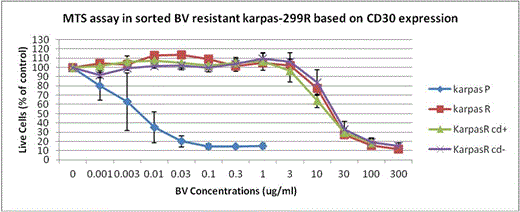Abstract
Background: Both Hodgkin lymphoma (HL) and anaplastic large cell lymphoma (ALCL) express surface CD30. Brentuximab vedotin (BV) is an antibody-drug conjugate that delivers a potent cytotoxic agent, monomethyl auristatin E (MMAE), specifically to cells expressing surface CD30. Although BV elicits a high response rate (75% in HL and 86% in ALCL), the majority of patients who do not attain complete response (CR) will eventually develop resistance to BV. It is not known whether resistance to BV is through a) CD 30 alterations b) resistance to cytotoxic agent MMAE or c) overexpression of drug exporters. We developed 2 BV-resistant cell models and obtained primary lymphoma samples from patients with relapsed/progressive disease post BV therapy. We examined CD30 expression, MMAE resistance, drug exporter expression, and gene expression profiles in vitro and in vivo to determine mechanisms of resistance to BV.
Methods: HL cell line(L428) and ALCL cell line (KARPAS 299) were used for in vitro experiments. The selection of BV resistant cell model (L428R and KARPAS 299R) used two different approaches (pulsatile or constant exposure). Both BV resistance and MMAE resistance were confirmed by MTS assays. CD30 expression was measured by flow cytometry,qRT-PCR, and Western blotting. Drug exporter expression was measured using qRT-PCR to MDR1, MRP1, and MRP3. In vivo experiments utilized primary tumor samples from 15 HL and 4 ALCL patients who had developed relapsed/progressive disease post BV treatment. CD30 expression was assessed by immunohistocytochemistry (IHC). Gene expression profiling was performed in both parental and resistant HL and ALCL cells, and in 4 ALCL primary tumor samples using Affymetrix whole genome GeneChip® Human Genome U133 2.0 Plus.
Results: MTS assay showed the IC50 of KARPAS 299R to BV shifted from 24 +/- 10 ng/ml to 28 +/- 9 ug/ml, an 1183-fold increase. MTS assay also showed the IC50 of KARPAS 299R to MMAE only increased 2-fold when compared to KARPAS 299. Flow cytometry showed downregulation of surface CD30 expression in KARPAS 299R as compared to KARPAS 299 parental (59% vs. 96%, median intensity 78 +/- 17 vs. 591 +/- 51). This downregulation was confirmed by qRT-PCR and Western blotting for CD30. As KARPAS 299R is a mixed cell population, we sorted them into CD30+ and CD30- subpopulations. We then analyzed for BV sensitivity based on CD 30 expression status in KARPAS 299R. MTS assay showed that KARPAS 299R CD30+ cells were equally as resistant to BV as KARPAS 299R CD30- cells (figure 1A). IHC performed in 4 ALCL primary tumor samples showed persistent CD 30 expression in relapsed/progressive tumor specimens post BV treatment.
Gene expression profiling on KARPAS 299R showed downregulation of CD30 as compared to KARPAS 299. Gene expression profiling on pre- and post-treatment ALCL samples (8) did not show significant differences in CD30 expression. The top four upregulated genes in relapsed/progressive samples as compared to pretreatment samples were LCE3D, WNT3, TNNT, CITED2. The top four downregulated genes in relapsed/progressive samples as compared to pretreatment samples were CXCL13, C4orf7, MS4A1, and IGJ.
MTS assay showed that the IC50 of L428R to BV has shifted from 32 +/- 11 ug/ml to 391 +/- 92 ug/ml, a 12-fold increase. MTS assays showed the IC50 of L428R to MMAE has increased 99-folds when compared to L428 (figure 1B). No difference was seen in CD 30 expression by flow cytometry, qRT-PCR, or western blotting between L428R vs. L428. IHC performed in 15 HL primary tumors show persistent CD30 expression in relapsed/progressive tumor specimen post-BV treatment. qRT-PCR showed upregulation of MDR1mRNA in L428R as compared to L428. Gene expression profiling on L428R showed upregulation of MDR1 as compared to L428.
Conclusion: Downregulation of CD30 is seen in BV-resistant ALCL cell model. However, sensitivity to BV did not depend solely on the level of CD30 expression as CD30+ cell subpopulations still exhibited resistance to BV in vitro. Upregulation of MDR-1 and resistance to MMAE were seen in BV-resistant HL cells, rather than downregluation of CD30. Downregulation of CD30 was not seen in HL or ALCL primary tumors. Further work is ongoing to explore/validate potential targets derived from gene expression profiling in ALCL primary tumors.
Chen:Seattle Genetics, Inc.: Consultancy, Research Funding, Speakers Bureau, Travel expenses Other.
Author notes
Asterisk with author names denotes non-ASH members.



This feature is available to Subscribers Only
Sign In or Create an Account Close Modal